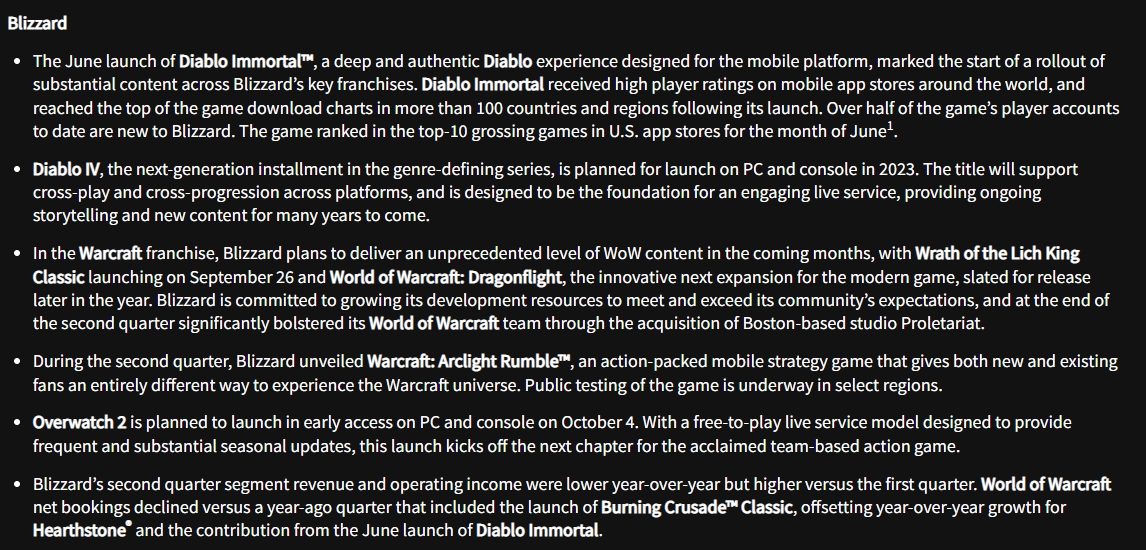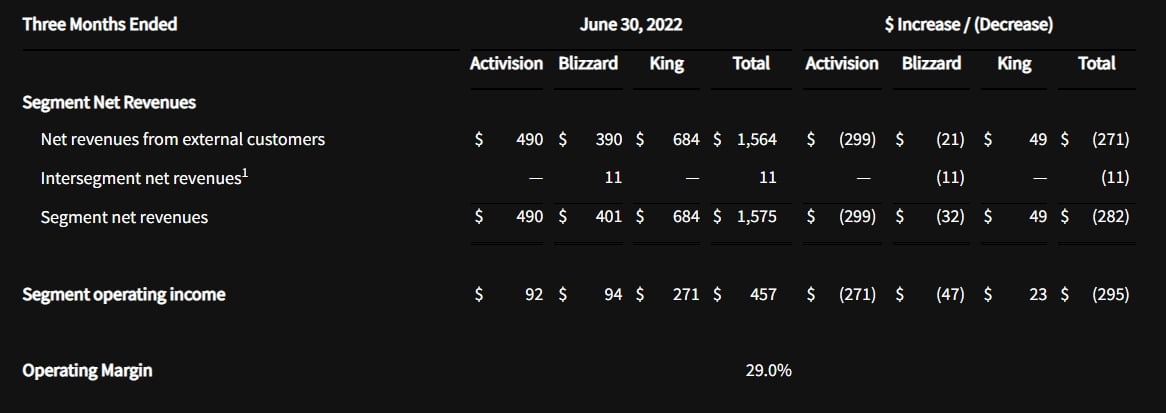
Welcome back to our regular coverage of Activision-Blizzard’s quarterly financials. As of this afternoon, we have Q2’s results, comprising April, May, and June 2022; let’s break it down, first with ABK and then with Blizzard itself.
Activision-Blizzard on the whole brought in $1.64B in revenue for the quarter, which amounts to yet another a large drop – 29% – compared to Q2 2021 (we’ve got the running chart below). ABK also reported another drop in MAUs, down from 372M last quarter to 361M now. You know it’s bad when Bobby Kotick’s blurb dodges left and right, talking up its acquisitions, AI, headcount, future releases, and investor profits.
The company does acknowledge the looming recession, promising to deliver on its pipeline later in the year: “Based on the current pipeline, total segment operating income is expected to increase modestly in the third quarter versus the second quarter, and to return to year-over-year growth in the fourth quarter.”
ABK Q1-22: $1.77B
ABK Q4-21: $2.163B
ABK Q3-21: $2.07B
ABK Q2-21: $2.30B
ABK Q1-21: $2.28B
ABK Q4-20: $2.41B
ABK 2021: $8.80B
ABK 2020: $8.09B
Blizzard Q1-22: $274M
Blizzard Q4-21: $419M
Blizzard Q3-21: $493M
Blizzard Q2-21: $433M
Blizzard Q1-21: $483M
Blizzard Q4-20: $579M
Blizzard 2021: $1.827B
Blizzard 2020: $1.905B
Blizz MAUs Q1-22: 22M
Blizz MAUs Q4-21: 24M
Blizz MAUs Q3-21: 26M
Blizz MAUS Q2-21: 26M
Blizz MAUs Q1-21: 27M
Blizz MAUs Q4-20: 29M
Blizz MAUs Q1-19: 32M
Blizz MAUs Q1-18: 38M
As for Blizzard itself, we might have expected a massive turnaround for the division this quarter, thanks to the reveal of World of Warcraft’s Dragonflight expansion, the reveal of WoW Classic’s Wrath of the Lich King expansion, Overwatch 2’s beta and of early access plan for this fall, a launch window plan for Diablo IV, and of course, the launch of Diablo Immortal, which as third-party analytics already suggests made a significant sum of money, though last week’s Chinese launch won’t be reflected until Q3. Last quarter, the company lost another 2M players in spite of the release of Eternity’s End in WoW, calculating to a 42% decrease in its playerbase in four years, and its revenues for the quarter and year as a whole were in deep decline, with a plummet of 43% QoQ.
However, in Q2 Blizzard revenue was down quarter-over-quarter yet again, though up compared to last quarter (which was an absolute disaster as we noted); the studio brought in $401M in Q2 2022 compared to $433M in Q2 2021, about a 7.4% decline.
“Blizzard’s second quarter segment revenue and operating income were lower year-over-year but higher versus the first quarter,” the report admits. “World of Warcraft net bookings declined versus a year-ago quarter that included the launch of Burning Crusade Classic, offsetting year-over-year growth for Hearthstone and the contribution from the June launch of Diablo Immortal.” It’s worth rereading that sentence again to understand the true scale of Immortal vs. WoW Classic, though it’s also worth remembering that only the first month of Immortal is included in Q2.


Where the good news starts for Blizzard is in monthly active players: Blizzard MAUs are positive for the first time since… well, almost since Blizzard began reporting MAUs. Apparently, it attracted 27M MAUs, a net increase of 5M since last quarter. That brings the company back in line with its figures from early 2021, though of course it’s still down 29% since it switched to this system in 2018. Blizzard did say at one point that it had counted 10M players for Diablo Immortal, and in this release it suggests half of those were new to the Blizzard ecosystem, which would account for the 5M increase rather handily.

Our running tally for your convenience:
38M in Q1 2018
37M in Q2 2018
37M in Q3 2018 (BFA)
35M in Q4 2018 (mass layoffs)
32M in Q1 2019
32M in Q2 2019
33M in Q3 2019 (WoW Classic)
32M in Q4 2019 (Blitzchung)
32M in Q1 2020 (COVID-19)
32M in Q2 2020 (COVID-19)
30M in Q3 2020 (COVID-19)
29M in Q4 2020 (COVID-19, Shadowlands)
27M in Q1 2021
26M in Q2 2021 (TBC Classic, WoW 9.1)
26M in Q3 2021 (D2R, lawsuits)
24M in Q4 2021 (Lawsuits, drought)
22M in Q1 2022 (Lawsuits, drought)
27M in Q2 2022 (Diablo Immortal)
As always, we note here that Blizzard intentionally reports MAUs this way to obfuscate which games are gaining and losing players, and traditionally it notes whenever a game had increased in MAUs. It hasn’t done that for many games for the last few quarters, Diablo Immortal being the obvious exception now, which has led us to assume the other games continue their decline.
In case you’re wondering, King is still doing great! Candy Crush propelled the King segment another revenue gain for the quarter.
Activision-Blizzard has once again said it won’t be “hosting a conference call, issuing an earnings presentation, or providing financial guidance” pending the Microsoft buyout, which is still almost a year away from completion, which is honestly a blessing because listening to those things is no fun anyhow.
Ahead of the release, Nasdaq.com’s blog discussed ATVI’s pair of consecutive bottom-line misses, noting that analysts were divided on whether Q2 would be a third miss or a rebound. It also pointed out in spite of the huge boost from the last-minute Microsoft announcement, stock shares are still down 4.3% over the last year, leading to a “unique” one-year chart of share performance and a “highly elevated” share valuation.
Here’s the full recap since 2015:
As longtime readers surely know, Activision-Blizzard, its leadership, and its games have been the subject of much-deserved criticism and scrutiny the last few years following an absolutely absurd list of scandals, including multiple rounds of mass layoffs, the Blitzchung boycott, C-suite payouts, shady stock deals/votes, abusive compensation, labor uprisings, a mass exodus of devs, plummeting playerbases, falling revenues, the ongoing sexual discrimination/harassment lawsuit, federal investigations, fired execs, destruction of evidence, workplace mismanagement, the strike, unionization attempts, unionbusting efforts, allegations against Bobby Kotick, stock drops, and the Microsoft buyout. On the gaming side, we’ve seen pipeline struggles, canceled BlizzCons, missed cadences, major delays and scope reduction, and of course the massive uproar over Diablo Immortal’s grotesque monetization.














